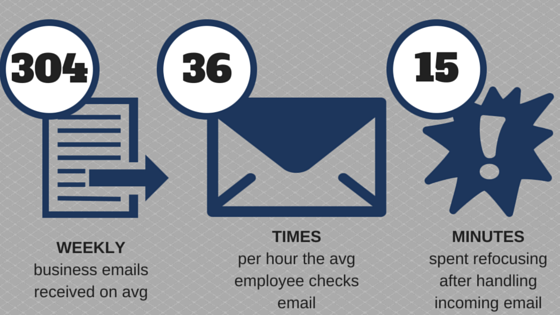
By Brooke Ballard, {grow} Contributing Columnist
I don’t know about you, but there are MANY days when I want to throw my computer out of a window because of a misinterpreted email.
People simply are not reading your emails. They merely scan them in the hope of grasping the context of your business communications.
This leads to a lot of back and forth, re-explaining, and resisting the urge to highlight, bold and underline the main points of your email.
Cue me banging my head against my desk instead …
Why Are Business Communications So Mucked Up?
Although we’d like to reference the idiots we’re surrounded by who clearly DON’T READ, let’s take a step back and start with ourselves.
Often times, we send an email assuming that the person on the other end knows exactly what we’re talking about.
But with increasing workloads and the constant onslaught of communications, notifications and information we’re receiving, your recipient may need more context to catch up.
Help jog the memory of the person you’re sending messages to for better business communications:
- Including the backstory (example: “In our meeting on Tuesday of this week, you requested I send you XYZ. Please find it attached and remember that I need XYZ [deliverable(s)] from you by [date].”
- Including any relevant links
- Copying team members who were/are involved in the conversation or project
- Being brief
- Using scannable text where possible, like numbers or bullets
MY “magic” messaging trick to add context and create better business communications?
These six words …
“What I’m hearing you say is …”
That’s interchangeable with things like:
- “What I’m sensing you need is ….”
- “I can help you by giving/doing/sending …”
Six words. They may seem simple but in reality you’re showing that you’ve listened to what they need AND you’re ensuring that the communications and context you’ve received are moving you in the right direction.
How To Provide Context For Better Business Communications [Template]
If using, “What I’m hearing you say is ….” doesn’t work for you in a sales scenario, try this dead simple template on for size to get your message understood clearly (and to stand out from the pack).
Hi, Brooke!
Thank you so much for the opportunity to help you meet your marketing and communication needs. [I always start with THANK YOU! It shows you’re grateful]
As I understand it [another way of saying, “What I’m hearing you say is …”], your team’s efforts are not being appreciated by the staff, which is causing IT-related projects to be seen as frivolous or costly. [State the problem again, specifically]
You would like to increase awareness of the benefits your IT-related programs provide for the staff, as well as improve communication processes between your CIO and the workers whose jobs are impacted positively by your projects. [State what they’re asking for, or what you’re being tasked with]
Please find my suggestions attached. [Solution to the stated problem]
Based on the four main areas and suggested channels, these are ways in which I believe the ITS team can effectively start to market and communicate internally. [Curiousity attempt / indirect call-to-action to open my attachment]
My pricing for a project of this scope is XYZ. [Qualifying statement]
We can get started on a proposal as soon as I get the green light from you. [Direct call-to-action]
Even if you’re not pitching someone, a similar template works:
Hi, Brooke!
Thank you so much for joining me for lunch/attending my webinar/making it to the meeting. [I always start with THANK YOU! It shows you’re grateful]
As I understand it [another way of saying, “What I’m hearing you say is …”], you need help with/you’re looking for X deliverables/you want follow up regarding Y. [State the problem again, specifically]
By giving you this help/proving these deliverables/follow up with Z, you/your team will [insert benefit statement here]. [State what they’re asking for, or what you’re being tasked with]
Please find my suggestions/deliverables/follow up attached/listed below. [Solution to the stated problem]
Based on your [stated problem/needs], these are ways in which I believe we can [solve the problem]. Don’t you agree? [Curiousity attempt / indirect call-to-action to open my attachment]
Do me a favor and respond at your earliest convenience to let me know if this/these [deliverable(s)] will get us to the finish line, or if I need to provide more XYZ. [Direct call-to-action]
I get it. This takes time. This is not as simple as a four-word sentence with no punctuation … and your schedule is crazy pants until next year.
But does it make more sense to invest a little time with the front end of to better business communications versus spending hours upon hours going back and forth?
Is it fair to constantly put the blame on others, or is it time to start being proactive versus reactive?
For me, this is a business New Year’s resolution that’s come early.
I know these templates or using “What I’m hearing you say is …” won’t solve every email misfire.
At least by taking the responsibility into my own hands I can steer the effectiveness of my email and business communications in a better, more productive direction.
What about you? Be honest. Will you keep blaming the non-reading fools, or does placing the responsibility of better communications on your own shoulders seem more effective?
 Brooke Ballard is an in-the-trenches digital marketer & owner at B Squared Media, blossoming blogger, and a purveyor of psychographics. Her mantra is “Think Conversation, Not Campaign” so be sure to give her a shout on Twitter.
Brooke Ballard is an in-the-trenches digital marketer & owner at B Squared Media, blossoming blogger, and a purveyor of psychographics. Her mantra is “Think Conversation, Not Campaign” so be sure to give her a shout on Twitter.
Top illustration courtesy Flickr CC and Liz West
Infographic courtesy Atlassian blog



